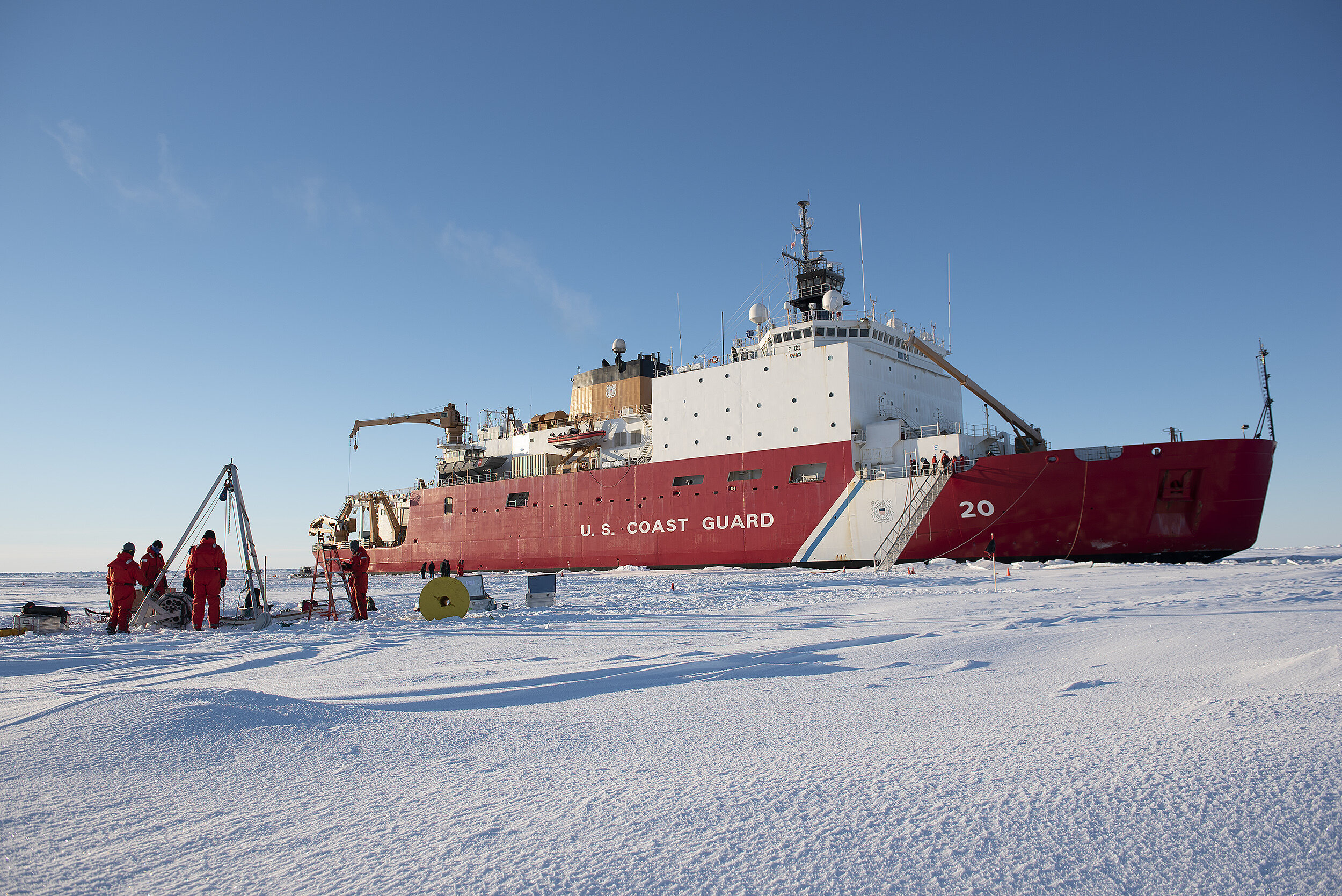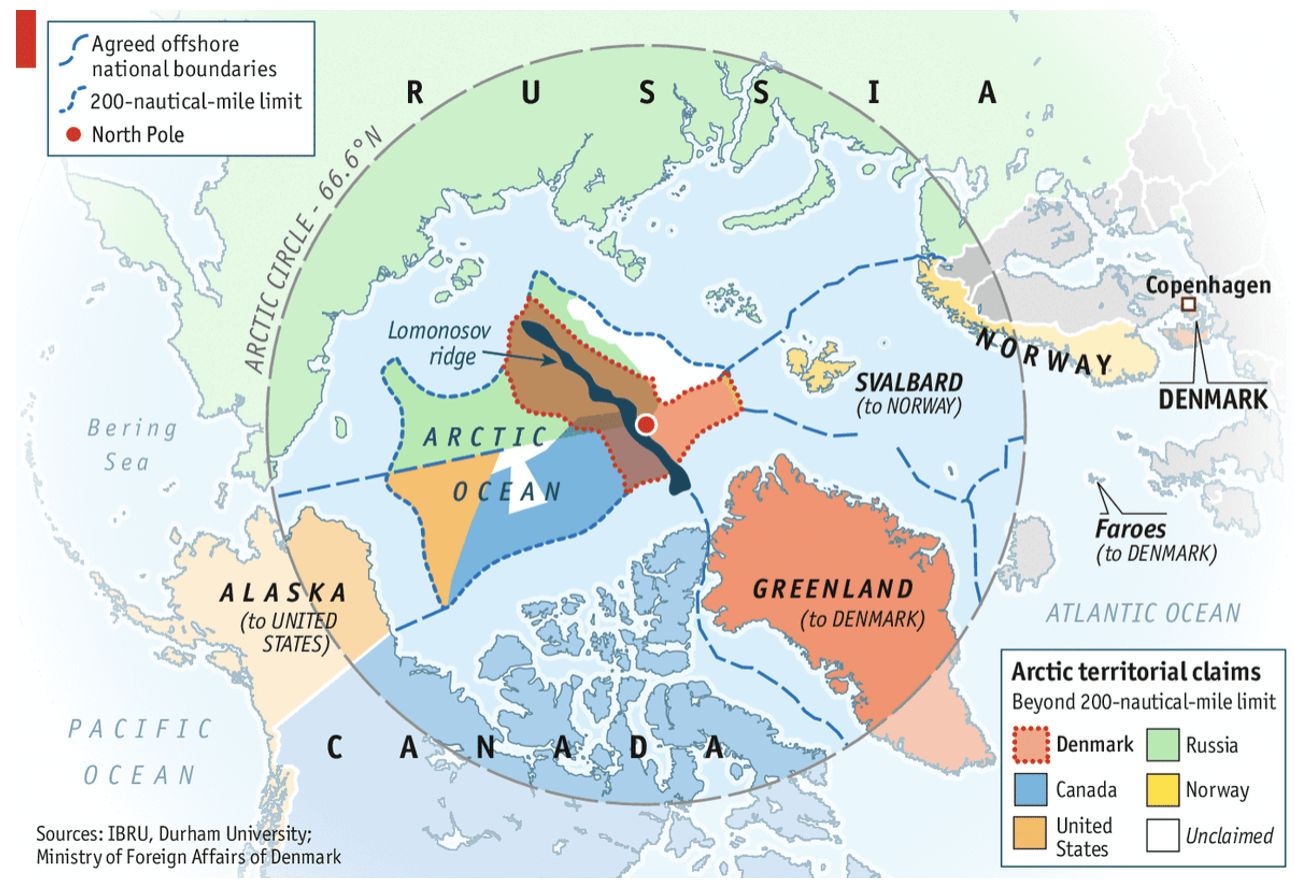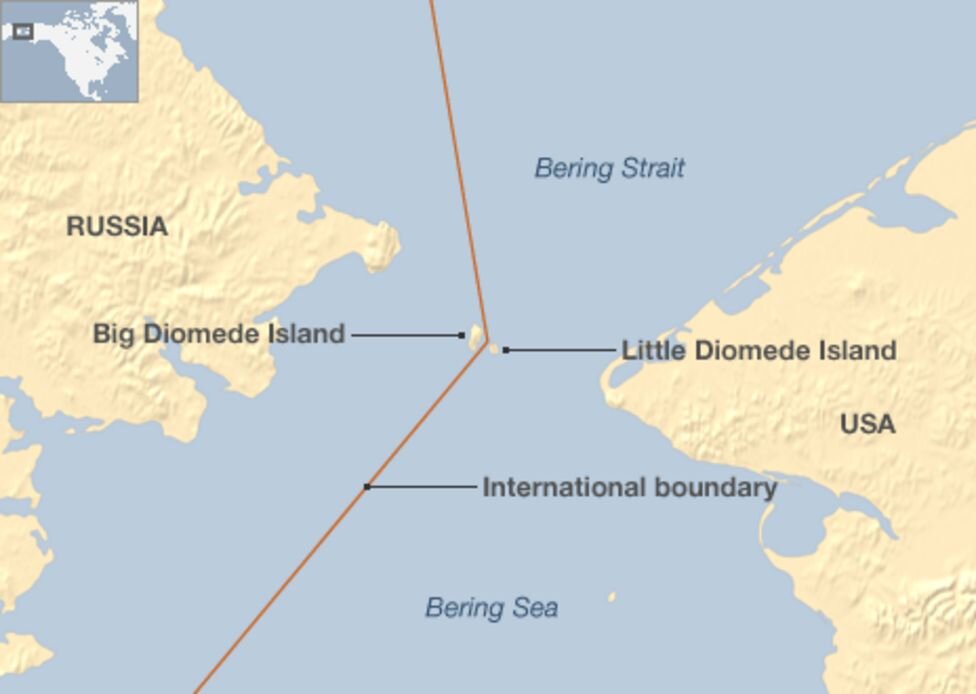What Happens When the Ice Melts? A Look at Russian and Chinese ‘Arctic Strategies’ and their Implications for the U.S.
A U.S. Coast Guard Ice Breaker vessel patrolling the frozen Arctic Ocean. Source.
Receding sea ice and melting permafrost in the Arctic are reshaping the security and economic landscape of the far north. New shipping lanes, previously un-navigable because of ice, could be available for commercial shipping year-round by 2030. While the Arctic Council has created a space for collaboration and exchange amongst Arctic states for the past 25 years, the potential for economic gain and unique national security concerns could erode cooperation and add a new dynamic to power competitions in the Arctic. Here’s what the world will be watching over the coming decade of Arctic politics.
The Littoral Arctic States
There are five littoral Arctic states: Canada, Denmark (via Greenland), Norway, Russia, and the United States (U.S.). According to the UN Convention on the Laws of the Sea, these states have exclusive rights to resources within 200 nautical-miles of their border and the area beyond these exclusive economic zones (EEZ) is considered international waters. Beyond the borders of the EEZ’s, there are overlapping claims to the continental shelf.
Map of Arctic Territorial Claims and EEZ Boundaries. Source
The Arctic Council
The Arctic Council (the Council) was established in 1996 by the Ottawa Declaration to “provide a means for promoting cooperation, coordination and interaction among the Arctic States, with the involvement of the Arctic indigenous communities and other Arctic inhabitants on common Arctic issues, in particular issues of sustainable development and environmental protection in the Arctic.” The members of the Arctic Council include the littoral Arctic states as well as Sweden, Finland, and Iceland. Collectively, the eight states are known as the Arctic States. The Council also includes the Aleut International Association, Arctic Athabaskan Council, Gwich’in Council International, Inuit Circumpolar Council, Russian Association of Indigenous Peoples of the North, and the Saami Council as permanent participants to represent Arctic Indigenous peoples. The Council also approves various states and governmental organizations as observers. State observers include China, India, South Korea, Singapore, Switzerland and India as well as NATO members France, Germany, Italy, Netherlands, Poland, Spain and the United Kingdom. Thus far, the Arctic Council has successfully encouraged cooperation and dialogue amongst member states partnering on key issues like environmental protection and joint projects on mapping and navigation. However, the changing physical landscape of the Earth’s northernmost reach is opening up new economic opportunities that could create competition and national security concerns.
Economic Opportunities: Where Some States Could Find New Value
Russia
Perhaps the most immediate implication of melting ice is the potential for previously un-navigable shipping lanes to come into use. There are three primary potential routes for Arctic shipping: the Northern Sea Route, North West Passage, and the Transpolar Sea Route. The Northern Sea Route runs along the northern coast of Russia and would shorten the time from Asian markets to European markets by almost two weeks. The North-west Passage runs similar to the Northern Sea Route except along Canada’s border and will likely be navigable only several years after the Northern Sea Route due to a slower ice melting rate. The Transpolar Sea Route would only be possible if and when all the ice melts and the Arctic Ocean is freely navigable. This route would allow ships to sail mainly through international waters directly over the North Pole.
Map of Future Arctic Sea Routes. Source
Russia’s oil and natural gas reserves are highly concentrated in the Arctic region— including 95% of the nation’s natural gas reserves and 60% of its oil reserves— and increasing navigability of the Arctic waters has the potential for major economic benefits. 53% of Arctic coastline is Russian coastline and with 2 million Russian citizens living in the Arctic Circle, Russians account for half the total population of the region.
China
China’s position in the Arctic is a particularly interesting one considering it is not an Arctic state, although it has proclaimed itself a “near-Arctic state.” As part of its expansive Belt and Road economic initiative, Beijing views the Arctic as a “blue economic passage” of trade from Asia to Europe. Currently, to gain access to Europe or North America by sea, vessels leaving China must pass through the Suez Canal. However, the Northern Sea Route would be considerably faster and thus cheaper. Furthermore, it would avoid East African piracy which has at times plagued Chinese shipping. Therefore, Beijing has sought increased access to the Arctic Circle through scientific research and investment in Russian natural gas and oil projects.
Comparison of Northern Sea Route and Current Route via Suez Canal of vessels travelling from China to Europe. Source.
Beijing opened its first scientific research center in Norway in 2004 and has more recently opened the China-Russia Arctic Research Center. China has attempted to make multiple significant investments in infrastructure in Greenland which, at times, has been vetoed by Denmark after the U.S. expressed concerns about how increasing Chinese investment could lead to influence that would jeopardize the U.S. Air Force Thule Base. China has also increased trade and investments in Iceland’s infrastructure which has increased Iceland's dependence on continued investment from Beijing moving forward.
National Security Concerns
As economic potential builds in the region, so too does the potential for infringement in sovereign territory or waters. National militaries could become increasingly involved to protect states’ interests.
Russia
Perhaps the greatest national security concern for the U.S. in the Arctic comes from Russia. Since 2008, Russia has released five strategy documents regarding the development of its Arctic military capabilities. The most recent, released March 5, 2020, emphasized the role of defensive militarization in the role of preserving territorial sovereignty and a peaceful Arctic region. The strategy document calls the Arctic a “strategic resource base” and emphasizes the importance of ensuring its security. In many ways, these documents represent a continuation of an increasingly military-centric Arctic approach out of Moscow.
A similar document released in 2013 highlighted the Arctic as a national security priority. In 2014, in accordance with this priority, Russia established a new strategic command for the Arctic under its Northern Fleet. As of January 1, 2021 the Northern Fleet was given equal status as a military district by the Russian military, elevating and reflecting the increasing importance of the region. Since the 2013 policy directive, Moscow has reopened nearly 50 bases by building 475 military facilities. Russia’s Northern Fleet is based in the Kola Peninsula with a large nuclear arsenal. The Northern Fleet boasts an impressive array of weapons and ships including nuclear powered missiles, fast-attack submarines, ballistic missile submarines, anti-submarine capabilities, and the largest collection of nuclear and non-nuclear icebreakers. With 46 icebreakers, the Russian fleet only has one less than the rest of the world combined and 12 more than the rest of the Arctic states combined according to the U.S. Coast Guard.
In the years since 2013, Russia has increasingly used military exercises as a show of force and means to improve Arctic readiness. In March 2015, a year after the annexation of Crimea, Russia conducted a military exercise with a show of force including 40,000 troops, 15 submarines, and 41 warships. Vostok-18 in September 2018, Tsentr-19 in September 2019, Ocean Shield in August 2019, and Grom-19 in October 2019 each highlighted different elements such as new capabilities, large numbers of troops, and nuclear forces. The testing of hypersonic cruise missiles in particular has caught the attention of the previous Commander of the U.S. Northern Command, Terrence O'Shaughnessy, calling these cruise missiles “one of the biggest threats we face.”
Vostok-18 was the largest exercise conducted since a Soviet-era exercise in 1981 with over 300,000 troops, 1,000 aircraft, 80 ships, and 36,000 tanks. However, it was also particularly notable because it was the first time a Russian military exercise also included Chinese troops—an indication for many of increasing ties between the two states.
China
While the primary focus of Beijing’s Arctic policy is economic, there are elements of military buildup as well. China has built “ice-capable” boats and currently operates two icebreakers. Despite areas of cooperation between Russia and China over economic development, natural gas, and military collaboration generally, Moscow is vehemently opposed to the idea of any foreign icebreakers in the Northern Sea Passage, including Chinese icebreakers. In various five year military plans, Beijing has included the Arctic as a strategic region and directed resources towards investment and research to shape international norms. The increased investment in research, such as navigation or surveillance projects, could have both civilian and military purposes.
Implications for the U.S.
One potential point of contention between the U.S. and Russia as a result of increased passage along Arctic shipping lanes would be the Bering Strait. The Bering Strait is a 51-mile wide strait between the U.S. and Russia and is the closest point between the two countries. Two islands in the middle, Big and Little Diomede are 2.5 miles apart and the international boundary splits between the two. As of now, the U.S. and Russia have built upon historic cooperation within the region by agreeing to a plan to manage shipping routes through the narrow strait. However, as its importance as a chokehold on international trade increases tensions could flare. Internally, one potential problem for the U.S. Department of Defense is that the Bering Strait lies at the junction of the Indo-Pacific Command (PACOM), European Command (EUROCOM), and Northern Command (NORTHCOM) which could lead to inefficiencies and challenges coordinating a quick response to a potential security challenge. NORTHCOM has been given primary command over Arctic missions but also coordinates significantly with EUROCOM as evidenced by the last year patrols conducted last year by the USS Ross, part of the U.S. Navy’s 6th Fleet which is under EUROCOM. In a moment of crisis, coordinating between the two, especially if it involved ships coming up through the Pacific (which PACOM is responsible for), could be challenging. External challenges for the Department of Defense include increased Russian militarization, intimidation tactics, or use of electronic warfare capabilities.
Map of the Bering Strait and International Boundary Between the U.S. and Russia. Source.
The Arctic could become a new region for the current power competitions between the U.S. and Russia, the U.S. and China, and even Russia and China despite the latter two nations’ increased levels of cooperation. As the Biden Administration specifically seeks out multilateral cooperation, working with NATO members and the Arctic States more broadly will provide opportunities to both include Russia and maintain its own strategic interests. Increasing diplomatic and investment ties to counter Chinese proposals will likely be necessary to ensure that Beijing’s activities do not create a reliance on their investment that can be turned into leverage which they can wield against other Arctic states. Maintaining opportunities for the U.S. to engage in dialogue with other Arctic Council Observer States like South Korea or Japan, especially in regards to Chinese investment and research, will help ensure that regional allies are also a part of shaping international rules and order. While the Arctic Council has created a forum that has successfully promoted international cooperation with Arctic States, melting ice and the resulting increased access to natural resources and shipping lanes create questions with few answers.





